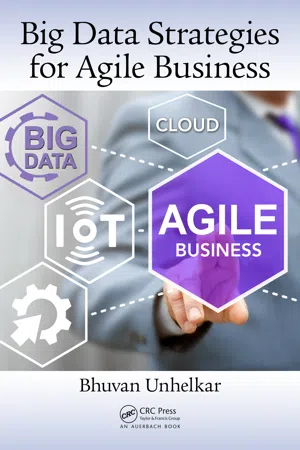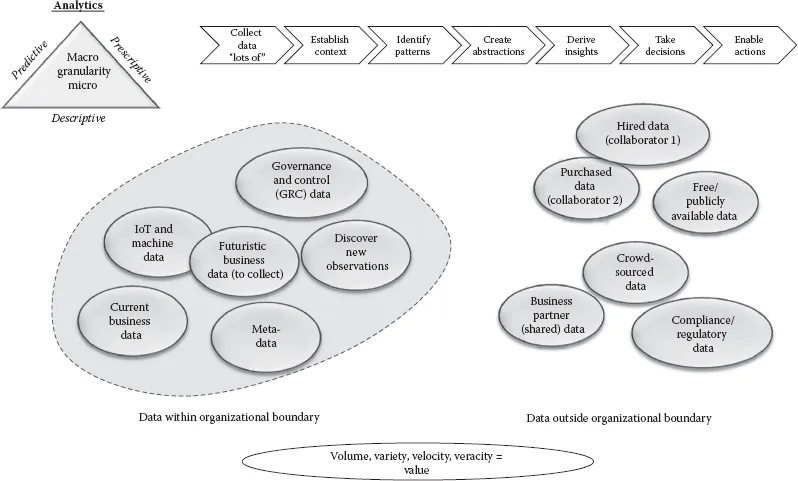
eBook - ePub
Big Data Strategies for Agile Business
Bhuvan Unhelkar
This is a test
- 503 pagine
- English
- ePUB (disponibile sull'app)
- Disponibile su iOS e Android
eBook - ePub
Big Data Strategies for Agile Business
Bhuvan Unhelkar
Dettagli del libro
Anteprima del libro
Indice dei contenuti
Citazioni
Informazioni sul libro
Agile is a set of values, principles, techniques, and frameworks for the adaptable, incremental, and efficient delivery of work. Big Data is a rapidly growing field that encompasses crucial aspects of data such as its volume, velocity, variety, and veracity. This book outlines a strategic approach to Big Data that will render a business Agile. It discusses the important competencies required to streamline and focus on the analytics and presents a roadmap for implementing such analytics in business.
Domande frequenti
Come faccio ad annullare l'abbonamento?
È semplicissimo: basta accedere alla sezione Account nelle Impostazioni e cliccare su "Annulla abbonamento". Dopo la cancellazione, l'abbonamento rimarrà attivo per il periodo rimanente già pagato. Per maggiori informazioni, clicca qui
È possibile scaricare libri? Se sì, come?
Al momento è possibile scaricare tramite l'app tutti i nostri libri ePub mobile-friendly. Anche la maggior parte dei nostri PDF è scaricabile e stiamo lavorando per rendere disponibile quanto prima il download di tutti gli altri file. Per maggiori informazioni, clicca qui
Che differenza c'è tra i piani?
Entrambi i piani ti danno accesso illimitato alla libreria e a tutte le funzionalità di Perlego. Le uniche differenze sono il prezzo e il periodo di abbonamento: con il piano annuale risparmierai circa il 30% rispetto a 12 rate con quello mensile.
Cos'è Perlego?
Perlego è un servizio di abbonamento a testi accademici, che ti permette di accedere a un'intera libreria online a un prezzo inferiore rispetto a quello che pagheresti per acquistare un singolo libro al mese. Con oltre 1 milione di testi suddivisi in più di 1.000 categorie, troverai sicuramente ciò che fa per te! Per maggiori informazioni, clicca qui.
Perlego supporta la sintesi vocale?
Cerca l'icona Sintesi vocale nel prossimo libro che leggerai per verificare se è possibile riprodurre l'audio. Questo strumento permette di leggere il testo a voce alta, evidenziandolo man mano che la lettura procede. Puoi aumentare o diminuire la velocità della sintesi vocale, oppure sospendere la riproduzione. Per maggiori informazioni, clicca qui.
Big Data Strategies for Agile Business è disponibile online in formato PDF/ePub?
Sì, puoi accedere a Big Data Strategies for Agile Business di Bhuvan Unhelkar in formato PDF e/o ePub, così come ad altri libri molto apprezzati nelle sezioni relative a Commerce e Gestion de l'information. Scopri oltre 1 milione di libri disponibili nel nostro catalogo.
Informazioni
Chapter 3
Data Science—Analytics, Context, and Strategies
Chapter Objectives






This chapter is mainly based on the second module of the Big Data Framework for Agile Business (BDFAB): data science—analytics, context, and technology. Specifically, as shown in Figure 2.1, this module draws attention to data, its various types and categories, and their utilization in analytics. Setting the context of a data point and the role of hex elementization in doing so is also discussed in this chapter. Furthermore, this chapter explains the crucial importance of granularity in data and analytics, and the setting of the OGL. Data science is presented as a discipline responsible for adopting and using Big Data in an iterative and incremental manner.
Data Science: Analytics, Context, and Strategies
Understanding the Importance of Data Science
Data science is a broad-ranging term that represents the technologies and analytics of Big Data. Additionally, though, data science can be understood as a discipline of utilizing technologies and analytics to convert data into actionable knowledge. Data science includes data mining, analytics (statistics), process modeling, machine learning (ML), parallel processing, and associated aspects of data management. The application of analytics to this data is the main step in arriving at insights. Therefore, data analytics remains at the core of data science. Data science, however, is closer to the business leadership and strategic decision making than data analytics. The evolution of data to actionable knowledge requires a specialist discipline that includes the study of data, its characteristics, its context in analytics, and eventually its value in business agility. These aforementioned activities require a wide coverage of various other disciplines within the organization and collaboration with many cross-functional teams. Therefore, the work of data science is interdisciplinary.
While analysis of data can focus on using the statistical expertise and management of data on the technical aspects, data science focuses on the strategic aspect of producing business value from data. This strategic aspect of data science requires domain knowledge of the industry where it is applied. For example, domain knowledge of the banking, finance, insurance, telecom, medical, and education industries is important in developing corresponding data strategies. Consider the following examples where data science provides value by combining the science of data with the domain knowledge:








Data science thus has wide-ranging applications in business decision making. Many internal organizational disciplines and functions provide input into data science. These are the disciplines of business strategies, project management, enterprise architecture, process modeling, solutions development, and quality assurance and testing. These disciplines complement those of data science. Figure 3.1 shows the effort involved in categorizing data, finding the correlation, undertaking analytics, and presenting the insights in an easy-to-use way for the end user.

Figure 3.1Data analytics, data categories (pools), and a subprocess for data transformation.
Data science considers the following in order to provide business value:




Indice dei contenuti
- Cover
- Half-Title
- Title
- Copyright
- Dedication
- Series
- Contents
- List of Figures
- List of Tables
- Foreword
- Preface
- Acknowledgements
- About the Author
- Domain Terms and Acronyms
- SECTION I INTRODUCTION TO BIG DATA STRATEGIES AND OUTLINE OF BIG DATA FRAMEWORK FOR AGILE BUSINESS (BDFAB)
- SECTION II ANALYTICS, PROCESSES, TECHNOLOGIES, ARCHITE CTURE, AND DATABASES WIT HIN THE BDFAB
- SECTION III QUALITY, GRC, PEOPLE AND THEIR UPSKILLING, AND AGILE BUSINESS WIT HIN THE BDFAB
- SECTION IV CASE STUDIES IN BANKING, HEALTH, AND EDUCATION
Stili delle citazioni per Big Data Strategies for Agile Business
APA 6 Citation
Unhelkar, B. (2017). Big Data Strategies for Agile Business (1st ed.). CRC Press. Retrieved from https://www.perlego.com/book/1515920/big-data-strategies-for-agile-business-pdf (Original work published 2017)
Chicago Citation
Unhelkar, Bhuvan. (2017) 2017. Big Data Strategies for Agile Business. 1st ed. CRC Press. https://www.perlego.com/book/1515920/big-data-strategies-for-agile-business-pdf.
Harvard Citation
Unhelkar, B. (2017) Big Data Strategies for Agile Business. 1st edn. CRC Press. Available at: https://www.perlego.com/book/1515920/big-data-strategies-for-agile-business-pdf (Accessed: 14 October 2022).
MLA 7 Citation
Unhelkar, Bhuvan. Big Data Strategies for Agile Business. 1st ed. CRC Press, 2017. Web. 14 Oct. 2022.